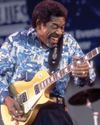
In the early 1970s, PBS Television in the USA showed an extended special entitled The World’s Greatest Unknown Guitarist. But this wasn’t strictly true; by 1971 Roy Buchanan had earned himself a reputation among the rock elite, reputedly being offered the position as Brian Jones’ successor in the Rolling Stones, at the peak of their career.
This documentary did however lead onto a recording contract with Polydor Records, going some way to redress Roy’s anonymity among the general public. Of the five albums he recorded for Polydor, and the three subsequent releases for Atlantic, two of these achieved gold status. However, Roy was never comfortable with purely commercial success, and loathed intervention from the record company. He wanted complete control over his music, leading to a period of recording inactivity starting in 1981.
Things were looking up when in 1985 Buchanan accepted a contract with Alligator Records, a deal that would give him the freedom he desired and lead to the classic releases When A Guitar Plays The Blues, and Hot Wires (1987). However, Buchanan’s personal life had its complications and tragedy was to strike in 1987, as Roy was found hanged in a police cell after being arrested for public intoxication. The official verdict was given as suicide.
This story is from the {{IssueName}} edition of {{MagazineName}}.
Start your 7-day Magzter GOLD free trial to access thousands of curated premium stories, and 9,000+ magazines and newspapers.
Already a subscriber ? Sign In
This story is from the {{IssueName}} edition of {{MagazineName}}.
Start your 7-day Magzter GOLD free trial to access thousands of curated premium stories, and 9,000+ magazines and newspapers.
Already a subscriber? Sign In

THE MOODY BLUES
This month Stuart Ryan delves into the picking style of this British prog legend whose acoustic guitar has powered many a Moody Blues song.

WAYNE KRANTZ
This issue Nick Mellor provides an insight into this brilliant jazz stylist, focusing on his approach to improvising over static chords.

OPEN G TUNING
Open tunings are great fun and can help create exciting new ideas. Simon Barnard shows how to incorporate open G tuning into your playing.

RODRIGO GOUVEIA
Last month we featured Mateus Asato, and mentioned the importance of the neo-soul style in his playing. Here we turn to his fellow Brazilian, the master of neo-soul fusion.

MARK KNOPFLER
Our topic this month is a master craftsman as both guitar player and songwriter. His style is unique and his influence spreads far and wide.

U2
Martin Cooper checks out the chiming pedal delay tones of this stadium-filling band from Dublin, Ireland, and guitarist The Edge.

LUTHER ALLISON
It’s blues with a touch of soul this month, as David Gerrish explores the dynamic, expressive style of an often overlooked Chicago bluesman.

JOHANN KASPAR MERTZ Capriccio
This month Declan Zapala explores the music of Austria at the turn of the Romantic period with a fiery caprice to level up your fingers and unlock your inner virtuoso.

THE CROSSROADS Michael Landau
John Wheatcroft explores the playing of a session ace _ and blazing blues-rock maestro who graces the top-flight m band of singer-songwriting legend, James Taylor.

VIDEO MASTERCLASS Troy Redfern
This month GT welcomes this slide guitar virtuoso. If you've been wanting to take your slide playing to the next level then this is one's for you. With Jon Bishop.